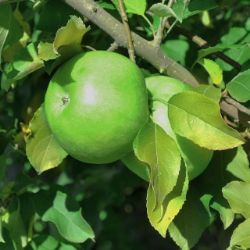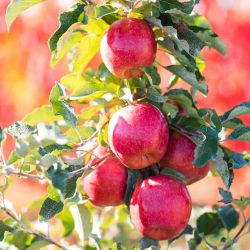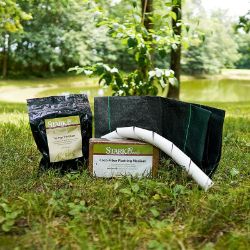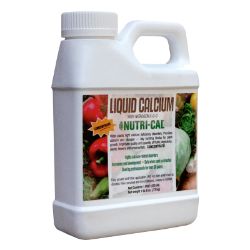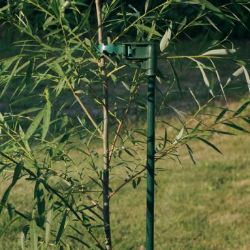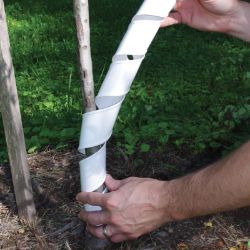Pest & Disease Control for Apple Trees
As it grows, an apple tree may experience issues such as the presence of pests or diseases. Factors such as location, weather, and upkeep play a part in which issues your apple tree encounters and how well it stands up against them. Disease-resistant apple trees are easy-care options for growers who prefer a low-spray or no-spray orchard, and – for all apple trees – routine maintenance* can help keep most problems at bay.
*Examples of good practices are: adequate watering, fertilizing as needed, seasonal pruning, preventative and active spraying, fall cleanup, and winter protection.
NOTE: This is part 7 in a series of 11 articles. For a complete background on how to grow apple trees, we recommend starting from the beginning.
The following are merely intended as a means of identifying potential issues. Don’t be alarmed – an apple tree may experience a few of these in its lifetime, but certainly not all at once.
Apple Tree Pests
Aphids
Tiny, pinhead-sized insects, varying in color depending on the type. Will cluster on stems and under leaves, sucking plant juices.
Symptoms: Leaves curl, thicken, yellow, and die. Aphids produce large amounts of a sticky residue called “honeydew” that attracts insects like ants. Honeydew becomes a growth medium for sooty mold.
Control: Spray
- GardenTech® Sevin® Concentrate Bug Killer
- Monterey Fruit Tree Spray Plus
Control: Natural Spray
- Monterey Fruit Tree Spray Plus
- Monterey Horticultural Oil
- Safer® Brand Insect Killing Soap
- Monterey Complete Disease Control
- Natural Guard® Neem
- Ferti-lome® Triple Action
Apple Maggot
Adults are similar in appearance to a housefly, but smaller. Larvae are yellowish-white grubs. Traps are an option for luring adults.
Symptoms: Small, pinpoint-sting marks visible on fruit surface. Eggs are laid under fruit skin. Hatched larvae tunnel, making railroad-like mining pattern.
Control: Spray
- GardenTech® Sevin® Concentrate Bug Killer
- Monterey Fruit Tree Spray Plus
Control: Natural Spray
- Monterey Fruit Tree Spray Plus
- Ferti-lome® Triple Action
Bud Moth
Adult female moth is around 1/2-inch long; male is slightly smaller. Color varies from mottled gray to brown. Full-grown larvae are around 3/4-inch long. Pupae are brown and about 3/8-inch long.
Symptoms: Feeding occurs along leaf midrib and fruit. Shelters are created by rolling leaves and tying leaves to other leaves or fruit. Damage appears as tiny holes, irregular scarring, and areas of rot – generally found around the stem. Rot or corking around the stem occurs after the larvae have finished feeding and have pupated.
Control: Spray
- Monterey Fruit Tree Spray Plus
Control: Natural Spray
- Monterey Horticultural Oil
- Hi-Yield® Vegetable & Ornamental Insect Control
- Natural Guard® Caterpillar Killer Spray w/BT
Codling Moth
Adults are moths, gray with brown patches on wings. Larvae are worms, about 1-inch long. Pests and damage are similar to Oriental Fruit Moth. Traps are an option for luring moths.
Symptoms: Affected fruits will have holes from outside to core.
Control: Spray
- Monterey Fruit Tree Spray Plus
Control: Natural Spray
- Monterey Horticultural Oil
- Natural Guard® Caterpillar Killer Spray w/BT
Flatheaded Apple Tree Borer
Adults are small brown beetles that may target the graft location (in young apple trees) for laying eggs as well as damaged or sunken areas. Grubs have horseshoe-shaped heads and cream-colored bodies. Difficult to control once infested. Preventative spraying (including the ground around the roots) is a strong defense. Traps – in the form of tanglefoot-coated logs or posts that are later removed from the site and burned – are an option for luring adults.
Symptoms: A thick, gummy substance (sap) leaking from round holes on the trunk or in a crotch of the tree. Grubs tunnel through trunks, weakening and eventually killing the tree. Eggs hatch and larvae tunnel into tree’s vascular tissue.
Control: Manual
- If infested, use a fine wire to try to pierce, mash, or dig grubs out.
Control: Spray
- GardenTech® Sevin® Concentrate Bug Killer
Additional Resources
- Contact local county cooperative Extension for further advice
Gypsy Moth
Adults are moths, from cream white to grayish brown. Eggs are laid in masses along bark, limbs, and other areas on the tree and can overwinter to hatch when the weather is favorable. Eggs hatch into larvae, which are black, hairy caterpillars.
Symptoms: Defoliation through feeding – in extreme cases, severe enough defoliation to stress and weaken apple trees.
Control: Site Cleanup
- Keep site clear of dead limbs, branches, and other debris that female gypsy moths can use to lay eggs
Control: Natural Spray
- Monterey Horticultural Oil
- Natural Guard® Caterpillar Killer Spray w/BT
Japanese Beetle
Adult is a metallic-green beetle, which skeletonizes leaves. Larvae are cream-colored grubs that feed on turf roots prior to maturity. Turf pest-control may help reduce grub populations; check turf product labels for timing and control of grubs. Traps are an option for luring adult beetles.
Symptoms: Adults are often seen in groups – large infestations can cause stunted growth and stress by skeletonizing a majority of the leaves.
Control: Manual
- If infestation is minimal, knock Japanese beetles into a jar of soapy water solution (they will become immobile when frightened as a defense mechanism)
Control: Spray
- Monterey Fruit Tree Spray Plus
Leafhopper
Small, active, slender-winged insect appearing in various colors. Usually found on undersides of leaves.
Symptoms: Slows new growth; leaves become whitened, stippled, or mottled. Leaf tips may wither and die. Prone to carrying diseases to and from plants and trees; damaged caused by leafhoppers may be greater than the feeding done directly by the insect.
Control: Spray
- Monterey Fruit Tree Spray Plus
Control: Natural Spray
- Safer® Brand Insect Killing Soap
- Ferti-lome® Triple Action
- Monterey Fruit Tree Spray Plus
- Monterey Horticultural Oil
Leafroller
Pale yellow or green worms.
Symptoms: Leaves are rolled and webbed together where grubs feed. Foliage eventually becomes skeletonized with prolonged exposure to feeding.
Control: Spray
- GardenTech® Sevin® Concentrate Bug Killer
- Monterey Fruit Tree Spray Plus
Control: Natural Spray
- Monterey Horticultural Oil
- Hi-Yield® Vegetable & Ornamental Insect Control
- Natural Guard® Caterpillar Killer Spray w/BT
- Ferti-lome® Triple Action
- Natural Guard® Neem
- Monterey Fruit Tree Spray Plus
Mites
Pinpoint-sized arthropods, appearing in many different colors depending on the type. Often found on undersides of leaves.
Symptoms: Sap feeding causes a bronze appearance in leaves. Severe infestations exhibit some silken webbing. Droughts or dry spells are advantageous for mite infestations.
Control: Spray
- GardenTech® Sevin® Concentrate Bug Killer
- Monterey Fruit Tree Spray Plus
Control: Natural Spray
- Monterey Horticultural Oil
- Safer® Brand Insect Killing Soap
- Ferti-lome® Triple Action
- Natural Guard® Neem
- Monterey Fruit Tree Spray Plus
Plum Curculio
Adult is brownish gray, 1/5-inch long, hard-shelled beetle with a long snout and 4 humps on its back.
Symptoms: Cuts a crescent-shaped hole in fruit skins and lays eggs inside. Grubs hatch and tunnel within fruit. Fruit may drop prematurely or have grubs/worms or tunnels inside at harvest.
Control: Site Cleanup
- Remove dropped fruit as soon as it appears
Control: Spray
- Monterey Fruit Tree Spray Plus (timing is key – just after petal fall)
Red Bug
Insects are small (1/4 to 1/3-inch long) and red with a brownish mid section and black legs. Adults make small holes in leaves and feed on developing fruit.
Symptoms: Leaves become distorted and apples rough with dimples or a series of small rust spots. Produces one generation each year with hatching occurring before blossom time.
Control: Natural Spray
- Monterey Horticultural Oil
Scale
Usually on bark of young twigs and branches, encrusted with small (1/16-inch) hard, circular, scaly raised bumps with yellow centers. May also be on fruit.
Symptoms: Sap feeding weakens the tree.
Control: Spray
- GardenTech® Sevin® Concentrate Bug Killer
- Monterey Fruit Tree Spray Plus
Control: Natural Spray
- Monterey Horticultural Oil
- Safer® Brand Insect Killing Soap
- Monterey Fruit Tree Spray Plus
- Ferti-lome® Triple Action
- Natural Guard® Neem
Tarnished Plant Bug
Yellowish-brown, winged insect that may have black spots or red stripes.
Symptoms: Damage is caused by injecting toxins into buds and shoots, causing stunted vegetative growth and sunken areas (or “cat facing”) on fruit.
Control: Natural Spray
- Safer® Brand Insect Killing Soap
- Monterey Fruit Tree Spray Plus
- Ferti-lome® Triple Action
Tent Caterpillar
Adults are moths. Caterpillars are a hairy, grayish brown with cream-colored spots or stripes down the back.
Symptoms: Encases large areas in webbing and feeds on enclosed leaves.
Control: Site Cleanup
- Remove webs with a rake (caterpillars are removed with webs) and burn
Control: Spray
- Monterey Fruit Tree Spray Plus
Control: Natural Spray
- Safer® Brand Insect Killing Soap
- Natural Guard® Caterpillar Killer Spray w/BT
Thrips
Tiny, slender, fringed-wing insects ranging from 1/25-inch to 1/8-inch long. Nymphs are pale yellow and highly active. Adults are usually black or yellow-brown, but may have red, black, or white markings.
Symptoms: Feeding occurs on vegetation by puncturing and sucking up the contents causing appearance to be deformed or discolored (similar to damage by mites and lace bugs).
Control: Natural Spray
- Monterey Fruit Tree Spray Plus
- Safer® Brand Insect Killing Soap
- Monterey Horticultural Oil
Apple Tree Diseases
Anthracnose
Caused by Cryptosporiopsis curvispora – a fungus that is spread by splashing rain or irrigation. Favors cool, wet weather (like in the fall).
Symptoms: New cankers appear on bark as small circular spots that are red or purple when wet. When they enlarge they become sunken orange to brown areas in the bark. As the cankers age, bark sloughs off exposing wood beneath, or disintegrates exposing fibers that give the area a ‘fiddle string’ appearance. Cankers usually do not grow larger after first year’s growth. Brown spots appear on leaves and fruit. At harvest, the fungus may infect the fruit. Fruit lesions are circular, brown, and sunken with gray or cream centers (Bull’s Eye rot). Disease rarely kills tree, as it is usually confined to small branches and twigs.
Control: Natural Spray
- Monterey Liquid Copper Fungicide
- Natural Guard® Neem
- Monterey Fruit Tree Spray Plus
Bitter Rot
Caused by Glomerella cingulata – a fungus that is spread by splashing rain or irrigation. Favors warm, wet weather.
Symptoms: Small, brown sunken spots on fruit. Spots rapidly enlarge and deepen, and may appear as target-like concentric rings. If allowed to persist, spots worsen and spores are transmitted to nearby fruit. Spots rot fruit to the core and affected fruit will eventually mummify. Disease overwinters in mummified fruit, diseased limbs, and narrow protected areas.
Control: Site Cleanup
- Remove affected fruit and mummies as soon as they are detected
Control: Manual
- Prune for air circulation and light
- Remove dead, damaged, and diseased limbs whenever they appear
Control: Spray
- Monterey Fruit Tree Spray Plus
- Hi-Yield® Captan 50W Fungicide
Control: Natural Spray
- Monterey Liquid Copper Fungicide
Black Rot and Frog-Eye Leaf Spot
Caused by Botryosphaeria obtusa – a fungus that is spread by splashing rain or irrigation. Favors warm, wet weather.
Symptoms: On Fruit – Fruit infection can begin as soon as fruit begins to develop and will appear on young fruit as red flecks that develop into purple pimples. These spots do not grow much until fruit begins to mature. Spots on mature fruit are irregular – black with a red halo appearance. As the spots enlarge, a series of concentric rings form, which alternate from black to brown. Lesions stay firm and are not sunken. Fruit mummifies and remains attached to the tree. Rotting occurs in seed cavity or around core, caused by early infections, but these fruits tend to fall within a month after petal fall with no surface symptoms. On Foliage – Leaf symptoms begin 1-3 weeks after petal fall as small purple flecks. These enlarge into lesions with purple margins and tan- to brown-centers, resembling ‘frog eyes’. When heavily infected, defoliation may occur. On Limbs – May be reddish-brown sunken cankers on limbs. Winter injured trees, or dead, damaged, diseased limbs are highly susceptible to contracting these fungal issues.
Control: Site Cleanup
- Remove affected fruit and mummies as soon as they are detected
Control: Manual
- Prune for air circulation and light
- Remove dead, damaged, and diseased limbs whenever they appear
Control: Spray
- Hi-Yield® Captan 50W Fungicide
- Monterey Fruit Tree Spray Plus
Control: Natural Spray
- Monterey Liquid Copper Fungicide
Cedar Apple Rust
Caused by Gymnosporangium juniperi-virginianae – a fungus that is spread from cedars/junipers to apple trees by splashing rain or irrigation in spring. During dry weather, spores are transferred to cedars/junipers. Spores overwinter in cedar/juniper galls to start the cycle again the following year. Requires the presence of both apple trees and Eastern red cedar trees (most common) or other plants/trees in the Juniperus genus.
Symptoms: Small, pale yellow spots are present on upper leaf surfaces. Spots will enlarge and become orange with black specks in center. A mass of fungal spikes appear on undersides of leaves. Orange gelatinous galls appear in Eastern red cedar trees or plants/trees in the Juniperus genus in spring.
Control: Spray
- Monterey Fruit Tree Spray Plus
Control: Natural Spray
- Monterey Fruit Tree Spray Plus
- Ferti-lome® Triple Action
- Natural Guard® Neem
Control: Manual
- Both hosts need to be present for the disease cycle to persist. Remove neighboring cedar trees and junipers if possible/feasible.
- Plant rust-resistant apple varieties in areas prone to cedar apple rust. Spraying helps control rust symptoms, but will not completely control the disease.
Additional Resources
- Contact local county cooperative Extension for further advice
Crown Gall
Caused by Agrobacterium tumefaciens – a bacterium that inhabits the soil and causes rapid, abnormal growth (developing into galls). Can spread through injury to roots in the soil as well as through gardening tools carrying the bacterium.
Symptoms: Trees appear stunted and slow growing; leaves may be reduced in size. In mature, fruit-bearing aged trees, may see little or no fruit. Woody, tumor-like growths called galls appear, especially at the crown (ground level) and below. Growths can restrict water and nutrient flow, but often the damage isn’t extensive enough to cause immediate or total death. If tree has died, inspect roots for hard, woody ‘tumors’ to identify Crown Gall as the cause. Note: Crown Gall is not the only thing that can cause stunted trees.
Control: Spray
- Ferti-Lome® Fire Blight Spray
Additional Resources
- Contact local county cooperative Extension for further advice
Fireblight
Caused by Erwinia amylovora – a highly contagious bacterium that is spread to different areas (blossoms, twigs, etc.) with tender growth by wind, splashing rain or irrigation, birds, insects, and so on – especially through points of weakness like insect injury, hail damage, wind-whipping, and more. Favors cool to warm wet weather.
Symptoms: On Flowers – Blossoms and fruit spurs will look brown and withered and also look as if scorched by fire. On Foliage – Dark brown or blackened leaves appear as disease spreads. Do not confuse symptoms of fireblight for symptoms of drought, salt injury, or nutrient deficiency which may also present as browned leaves. Tips of branches curl, leaving a “Shepherd's Hook” appearance. Twigs and branches die back. On Bark – Cankers may form, housing orange bacterial ooze; the site of overwintering.
Control: Manual
- Avoid applying nitrogen fertilizers during high-risk seasons (cool, wet springs) as tender new growth is more susceptible to infection
- Cut back affected branches at least 6- to 8-inches below visible signs of infection. Disinfect shears between cuts with alcohol wipes or a solution of one-part bleach and ten-parts water.
Control: Site Cleanup
- Destroy or dispose of pruning debris. Fall clean up is essential; including all mummified fruits and leaves hanging on the tree.
Control: Spray
- Ferti-Lome® Fire Blight Spray
Control: Natural Spray
- Monterey Liquid Copper Fungicide
Additional Resources
- Contact local county cooperative Extension for further advice
- Understanding Fire Blight
Powdery Mildew
Caused by Podosphaera leucotricha – a fungus that overwinters in buds and emerges during humid, warm weather progressively throughout the growing season.
Symptoms: Whitish-gray powdery mold or felt-like patches on buds, young leaves, and twigs. Leaves may crinkle and curl upward. New shoots are stunted.
Control: Natural Spray
- Monterey Liquid Copper Fungicide
- Ferti-lome® Triple Action
- Monterey Fruit Tree Spray Plus
- Monterey Horticultural Oil
Scab
Caused by Venturia inaequalis – a fungus that overwinters in fallen leaves and pruning debris. Favors cool, wet weather (typically in spring).
Symptoms: Spots on young leaves are velvety and olive green turns black; leaves wither, curl and drop. Fruit also has spots, is deformed, knotty, cracked and drops.
Control: Manual
- Plant scab-resistant apple trees if possible, especially in areas where apple scab is a known issue
Control: Site Cleanup
- Remove and dispose of pruning debris. Fall clean up is essential to control overwintering fungus.
Control: Spray
- Monterey Fruit Tree Spray Plus
- Hi-Yield® Captan 50W Fungicide
Control: Natural Spray
- Monterey Fruit Tree Spray Plus
- Ferti-lome® Triple Action
Additional Resources:
- Contact local county cooperative Extension for further advice (including recommended scab-resistant varieties that are known to perform well in the area)
Sooty Blotch and Flyspeck
Caused by a complex of Peltaster fructicola, Geastrumia polystigmatis, Leptodontidium elatius, and Phyllachora pomigena as well as Schizathyrium pomi – fungal pathogens. Often develops together, since both diseases thrive under similar conditions. Each favors cool, wet weather (typically emerging in summer and early fall, but also seen in early spring).
Symptoms: Issues usually appear together. Olive-green smudges and tiny black dots on skin of apple. These fungal diseases survive on infected twigs and are spread by rains in spring and early summer. Symptoms appear as early as 2- to 3-weeks after petal fall. Damage is primarily superficial – little damage is done to the fruit’s flesh. Smudges or dots can often be rubbed or washed off with as little as water and some effort.
Control: Manual
- Prune for improved air circulation and light to naturally prevent fungal issues from forming
Control: Site Cleanup
- Collect and remove fallen leaves and fruit
Control: Spray
- Monterey Fruit Tree Spray Plus
- Hi-Yield® Captan 50W Fungicide
Control: Natural Spray
- Monterey Liquid Copper Fungicide
Other Apple Tree Issues
Bark Necrosis
This is a physiological disease – not one caused by fungus, bacterium, or virus – and has been related to boron deficiency or manganese toxicity.
Symptoms: Small elevations appear on surface of 1-2 year old wood. If the outer bark in the area(s) where these elevations occur is sliced away, dark dead areas will be revealed. May cause stunted terminal growth and in extreme cases, death of small terminal branches.
Control: Manual
- Test soil. If pH is below 5.7, boron deficiency may be occurring. Manganese may become soluble and be taken up by the roots to cause injury. Improve soil pH with garden lime if soil testing detects low pH.
Additional Resources
- Contact local county cooperative Extension for further advice (also for soil sample analysis)
No Blossoms or Fruit
Symptoms: Apple trees take about 2 to 5 years after planting (on average) before they bloom or bear fruit. If enough time has been allowed to pass, and the apple tree is otherwise healthy, there are a few things to do to help it become fruitful.
Control: Manual
- Make sure a pollinator variety is present. Most apple trees require another different variety of apple tree to be fruitful.
- Make sure your apple tree variety is recommended for your zone. Low winter temperatures can injure sensitive fruit buds, hindering the potential for fruit production.
- Space trees far enough apart to help avoid nutrient or light competition. Adequate space encourages a healthy and productive tree. Spacing can be estimated by the mature spread of the tree.
- Prune to help keep the fruiting wood and vegetative wood in balance so that there isn’t too much leaf development in lieu of blossom development in mature trees – or too much fruit-bud development and not enough leaves to “feed” the fruit.
- Know your soil. Soil conditions, and the presence of necessary nutrients, help keep an apple tree’s roots supplying nutrients through its vascular system. If the soil is poor, or poorly drained, this affects the health and viability of the tree as a whole. If the tree is being over-fertilized, especially with a fertilizer high in nitrogen, it may develop lush, vegetative growth (leaves and branches) instead of developing fruit buds or blooming.
Additional Resources
- Solving Fruit Tree Blooming & Bearing Problems
- Contact local county cooperative Extension for further advice
Sunscald and Sunburn (Scorching)
Scorching or sunburn occurs during hot, dry growing seasons – with or without humidity in the air, but most commonly when humidity is low. Brown, crispy edges appear on leaves.
Symptoms: Sunscald is also called winter injury or “southwest injury” as it commonly affects the south-west side of tree trunks during winter. Warm, clear days cause bark to expand and nights that are several degrees cooler will cause the bark to contract, damaging cells and causing splits and cracks in the trunk.
Control: Manual
- Protect trunks prior to winter with protective tree guards or a diluted solution of water and white latex paint (50/50).
- Water new trees every 7- to 10-days during the growing season (if no rain within the week) or as needed (as the soil becomes dry to the touch).
- During the growing season, consider constructing a temporary shade cloth to protect trees from the sun on hot, dry days. Water as needed (see above).
Additional Resources
Water Stress
Symptoms: Can relate to overwatering or underwatering. Overwatering commonly presents as pale green to yellow leaves and leaf drop. Can weaken a tree, lead to issues with root rot, and ultimately kill the tree. Underwatering often presents as discolored – often yellowed – dry leaves. Tree may appear to wilt overall and prolonged lack of water can kill the tree.
Control: Manual
- Water new trees every 7- to 10-days during the growing season (if no rain within the week) or as needed (as the soil becomes dry to the touch).
- If planted in a location where the soil does not adequately drain water after heavy rains (leading to standing water), relocate the tree as soon as possible.
- If drought-like conditions persist, consider slow-trickle drip irrigation to allow water to reach the roots rather than wash over soil surface.
Additional Resources
Wind Injury
Symptoms: Can involve injury such as leaning trees, uprooted trees, breaks, tears, or wind-burned foliage. Depending on the severity of the injury, an apple tree can either bounce back from minor damage or succumb to the wind-caused harm. This is determined on an individual basis and the health of the tree before the damage occurred.
Control: Manual
- Adequately tamp soil around the tree’s roots (and thoroughly water) at planting time to remove air pockets and ensure good contact with the soil. Air pockets and loose soil around the roots can cause the tree to rock easily in its planting hole, leaving it vulnerable to leaning or becoming uprooted.
- Use tree stakes for new trees, dwarf trees, and trees planted in high-wind areas to help support upright growth and avoid leaning, uprooting, and breaking.
- Selectively thin fruit that may be weighing down limbs to reduce stress from the weight, and avoid tears or breaks during gusty weather. Be aware: pests and disease may also take advantage of resulting broken or torn areas if damage occurs.
- If tender new foliage is blown or whipped around by the wind, it may appear discolored (dark – like a burn or bruise). This damaged growth can be removed to encourage healthy, new growth to take its place.















